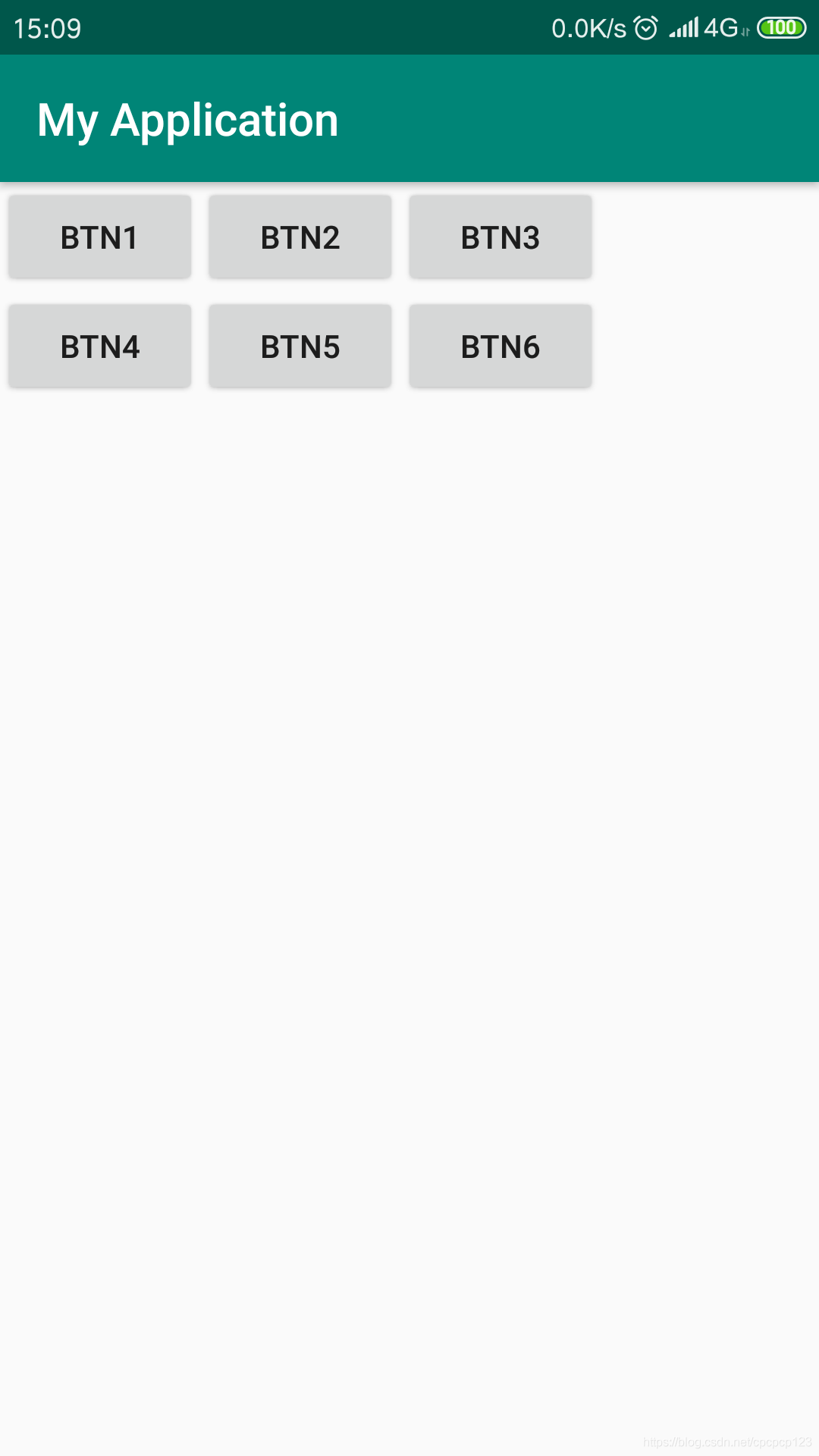Android TV 开发与一般Android开发最大的区别在于焦点控制 , 用户在使用Android TV设备主要是通过遥控器操作app。焦点就是让用户知道的直接交互行为。
方式一:在xml文件中控制焦点走向
主要是几个属性的使用:
focusable:一个控件是否能够获取聚焦
nextFocusRight:按右键要走到的控件ID
nextFocusLeft:按左键要走到的控件ID
nextFocusUp:按上键要走到的控件ID
nextFocusDown:按下键要走到的控件ID
requestFocus:前提是focusable为true,强制设置获取焦点
实验代码非常简单,六个按钮,来试验下焦点获取:

代码如下:
<?xml version="1.0" encoding="utf-8"?>
<RelativeLayout xmlns:android="http://schemas.android.com/apk/res/android"
xmlns:app="http://schemas.android.com/apk/res-auto"
xmlns:tools="http://schemas.android.com/tools"
android:layout_width="match_parent"
android:layout_height="match_parent">
<Button
android:id="@+id/btn1"
android:layout_width="wrap_content"
android:layout_height="wrap_content"
android:focusable="true"
android:nextFocusRight="@id/btn2"
android:nextFocusDown="@id/btn4"
android:text="btn1" />
<Button
android:id="@+id/btn2"
android:layout_width="wrap_content"
android:layout_height="wrap_content"
android:layout_toRightOf="@id/btn1"
android:nextFocusLeft="@id/btn1"
android:nextFocusRight="@id/btn3"
android:nextFocusDown="@id/btn5"
android:text="btn2" />
<Button
android:id="@+id/btn3"
android:layout_width="wrap_content"
android:layout_height="wrap_content"
android:layout_toRightOf="@id/btn2"
android:nextFocusLeft="@id/btn2"
android:nextFocusDown="@id/btn6"
android:nextFocusRight="@id/btn4"
android:text="btn3" />
<Button
android:id="@+id/btn4"
android:layout_width="wrap_content"
android:layout_height="wrap_content"
android:layout_below="@id/btn1"
android:nextFocusRight="@id/btn5"
android:nextFocusUp="@id/btn1"
android:nextFocusLeft="@id/btn3"
android:text="btn4" />
<Button
android:id="@+id/btn5"
android:layout_width="wrap_content"
android:layout_height="wrap_content"
android:layout_below="@id/btn1"
android:layout_toRightOf="@id/btn4"
android:nextFocusLeft="@id/btn4"
android:nextFocusRight="@id/btn6"
android:nextFocusUp="@id/btn2"
android:text="btn5" />
<Button
android:id="@+id/btn6"
android:layout_width="wrap_content"
android:layout_height="wrap_content"
android:layout_below="@id/btn3"
android:layout_toRightOf="@id/btn5"
android:nextFocusLeft="@id/btn5"
android:nextFocusUp="@id/btn3"
android:text="btn6" />
</RelativeLayout>正常来说第一行的btn3点击右键是无法定位到btn4的按钮上,但是在xml中我们设置了
android:nextFocusLeft="@id/btn2"
android:nextFocusDown="@id/btn6"
android:nextFocusRight="@id/btn4"
这三个属性,使得btn3在按下键时移动到btn6,在按右键时焦点移动到btn4,这样就完成了焦点移动的控制。当然,也可以使用Java代码控制。
方式二:在Java中控制焦点走向
我们要监控按钮的焦点,其实和我们监控按钮的点击事件一样,需要实现几个listener,例如焦点的
OnFocusChangeListener、按键的OnKeyListener
例如我们想控制btn3的按键右边为btn4,那么需要设置
btn3.setNextFocusRightId(btn4.getId());即可
整体代码如下:
import androidx.appcompat.app.AppCompatActivity;
import android.os.Bundle;
import android.view.KeyEvent;
import android.view.View;
import android.view.animation.ScaleAnimation;
import android.widget.Button;
import android.widget.Toast;
public class MainActivity extends AppCompatActivity implements
View.OnClickListener, View.OnFocusChangeListener, View.OnKeyListener {
Button btn1;
Button btn2;
Button btn3;
Button btn4;
Button btn5;
Button btn6;
@Override
protected void onCreate(Bundle savedInstanceState) {
super.onCreate(savedInstanceState);
setContentView(R.layout.activity_main);
btn1 = findViewById(R.id.btn1);
btn2 = findViewById(R.id.btn2);
btn3 = findViewById(R.id.btn3);
btn4 = findViewById(R.id.btn4);
btn5 = findViewById(R.id.btn5);
btn6 = findViewById(R.id.btn6);
btn1.setOnClickListener(this);
btn2.setOnClickListener(this);
btn3.setOnClickListener(this);
btn4.setOnClickListener(this);
btn5.setOnClickListener(this);
btn6.setOnClickListener(this);
btn3.setNextFocusRightId(btn4.getId());
btn4.setNextFocusLeftId(btn3.getId());
btn3.setOnFocusChangeListener(this);
btn4.setOnFocusChangeListener(this);
btn1.setOnKeyListener(this);
btn6.setOnKeyListener(this);
}
@Override
public void onClick(View v) {
int id = v.getId();
if (id == R.id.btn1) {
Toast.makeText(this, "btn1 click", Toast.LENGTH_SHORT).show();
}
}
@Override
public void onFocusChange(View v, boolean hasFocus) {
ScaleAnimation animation = new ScaleAnimation(1, 1.5f, 1, 1.5f);
animation.setDuration(500);
if (hasFocus) {
v.startAnimation(animation);
}
}
@Override
public boolean onKey(View v, int keyCode, KeyEvent event) {
if (event.getAction() == KeyEvent.ACTION_DOWN) {
int id = v.getId();
if (id == R.id.btn1) {
switch (keyCode) {
case KeyEvent.KEYCODE_DPAD_LEFT:
Toast.makeText(this, "btn1 无法向左", Toast.LENGTH_SHORT).show();
break;
default:
break;
}
} else if (id == R.id.btn6) {
switch (keyCode) {
case KeyEvent.KEYCODE_DPAD_RIGHT:
Toast.makeText(this, "btn6 无法向右", Toast.LENGTH_SHORT).show();
break;
default:
break;
}
}
}
return false;
}
}对应的xml布局文件:
<?xml version="1.0" encoding="utf-8"?>
<RelativeLayout xmlns:android="http://schemas.android.com/apk/res/android"
xmlns:app="http://schemas.android.com/apk/res-auto"
xmlns:tools="http://schemas.android.com/tools"
android:layout_width="match_parent"
android:layout_height="match_parent">
<Button
android:id="@+id/btn1"
android:layout_width="wrap_content"
android:layout_height="wrap_content"
android:focusable="true"
android:text="btn1" />
<Button
android:id="@+id/btn2"
android:layout_width="wrap_content"
android:layout_height="wrap_content"
android:layout_toRightOf="@id/btn1"
android:focusable="true"
android:text="btn2" />
<Button
android:id="@+id/btn3"
android:layout_width="wrap_content"
android:layout_height="wrap_content"
android:layout_toRightOf="@id/btn2"
android:focusable="true"
android:text="btn3" />
<Button
android:id="@+id/btn4"
android:layout_width="wrap_content"
android:layout_height="wrap_content"
android:layout_below="@id/btn1"
android:focusable="true"
android:text="btn4" />
<Button
android:id="@+id/btn5"
android:layout_width="wrap_content"
android:layout_height="wrap_content"
android:layout_below="@id/btn1"
android:layout_toRightOf="@id/btn4"
android:focusable="true"
android:text="btn5" />
<Button
android:id="@+id/btn6"
android:layout_width="wrap_content"
android:layout_height="wrap_content"
android:layout_below="@id/btn3"
android:layout_toRightOf="@id/btn5"
android:focusable="true"
android:text="btn6" />
</RelativeLayout>其实很简单,和监听按钮的点击事件一样,只是需要我们自己控制好,各个按钮在获取焦点时,或者边界点击时我们想要达到的效果即可。
